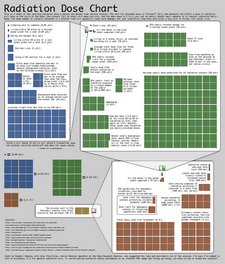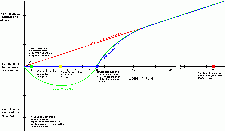 [1]Since things are settling in at Fukushima for the long haul, I thought that I’d take a moment or two and discuss the nature and effects of radiation. Lots of folks talk about radiation but few outside the industry know much about it.
[1]Since things are settling in at Fukushima for the long haul, I thought that I’d take a moment or two and discuss the nature and effects of radiation. Lots of folks talk about radiation but few outside the industry know much about it.
I want to take a moment here to congratulate TEPCO (Tokyo Electric Power Company) for the excellent job they’ve done in keeping the public informed and for feeding us knowledgeable people the raw data we need to do our own analysis. The graphic to the left is from one of their daily reports (available here [2]). It shows the location of towns around the nuclear plant and the dose rates in some of those towns. The entire graphic is much larger. I trimmed out a hunk that we can use for discussion. The selected graphic shows dose vs time in a couple of towns that showed the highest readings. Note that the raw data that went into the graphic are also available from the TEPCO site. Just in case you want to play around with the data yourself.
What is dose? And what is a Sievert or a Roentgen? I’m going to deal with definitions only briefly here. Otherwise I’d be writing a book. For more information than you probably care to know, go to the Health-Physics Society [3] website. In particular, look at this PowerPoint presentation [4] and this document [5] that discusses the effects of radiation.
OK, you’ve read those documents and you now know the definitions of Roentgens (R), Radiation Absorbed Dose (RAD) and Radiation Equivalent Man (REM). Oh, and just to confuse things a bit, the SI unit of dose is the Sievert. 1 S = 100 R. Isn’t that nice…
 [6]One of the most valuable tools I’ve ever seen in evaluating low level dose and its sources is this wonderful graphic prepared by Randall Munroe, creator of the hilarious nerd comic xkcd.com [7]. In addition to being a gifted comic and artist, Randall is also a physicist. If you have a molecule of nerd blood in your body, you ought to read this comic three times a week.
[6]One of the most valuable tools I’ve ever seen in evaluating low level dose and its sources is this wonderful graphic prepared by Randall Munroe, creator of the hilarious nerd comic xkcd.com [7]. In addition to being a gifted comic and artist, Randall is also a physicist. If you have a molecule of nerd blood in your body, you ought to read this comic three times a week.
Anyway, he designed this graphic that puts radiation exposure, especially low level exposure in perspective. I recommend printing it out on as large a printer as you can find so as to fully appreciate all the details.
One way to get a better feel for the effects of ionizing radiation is to look at its effects. In this discussion I’ll be talking about beta/gamma (primarily gamma) exposure that comes from a source external to the body. Internal dose from radioactive materials that are ingested or inhaled is a much more complicated issue that I won’t delve into with this post.
The damage or perhaps also good done by radiation depends upon both the total amount (dose) and the rate at which it is delivered (dose rate). To illustrate this, I use the analogy of a bullet.
If someone shoots you in the chest with a bullet carrying 1000 ft-lbs of energy, you will likely die. OTOH, if someone takes that same bullet and taps you on the chest with that bullet once a minute with 1 ft-lb of energy and does so for 1000 minutes, you certainly won’t be dead. Annoyed, maybe, but not dead.
This analogy holds true for toxins of all sorts. If a certain dose of botulin toxin will kill you if consumed over a short period of time, it should be intuitive that the same dose administered over say, a year will have no effect at all.
Some chemicals, while toxic in large doses, are actually beneficial in small ones. Take chromium. It’s a toxic metal but at the same time it’s a vital trace nutrient. Witness the fad with chromium picolinate as a “supplement”.
In radiation protection circles, a debate has raged for >40 years over the effects of low level radiation of the sort being experienced by workers at Fukushima and the immediate surroundings. The effects of high level exposures to radiation are well known and characterized. What we’re interested in is the effects of low levels. I have a strongly held opinion which I’ll get into in a bit. But first some definitions.
There are three theories of of the effects of low level radiation exposure.
-
Linear, no-threshold (LNT) effect.
-
Threshold effect
-
Hormesis (beneficial) effect.
 [8]The three theories are illustrated in this graphic. Let’s look at LNT first.
[8]The three theories are illustrated in this graphic. Let’s look at LNT first.
LNT theory says that any amount of radiation is harmful and the effect is the same irrespective of the dose rate. While this might seem reasonable, it doesn’t make sense in the real world. Using the bullet analogy again, this theory says that the target would be dead when 1000 ft-lbs of energy was administered, whether it came all in one shot or 1000 little annoyances.
Unfortunately LNT is the law. That’s what we have to base radiation protection on. It has led to a concept known as ALARA (as low as reasonable achievable). ALARA says that we reduce dose as much as we reasonably can regardless of what it is now. That’s not a bad concept in that it is most conservative and it leads to cleaner and lesser contaminated workplaces. Sometimes the definition of “reasonable” gets bent out of shape… LNT is represented by the red trace on the graphic.
The threshold theory states that below a certain dose delivered over a short time interval, nothing at all happens. Then at some threshold value, the risk of cancer starts increasing rapidly so that at a certain point the dose vs risk curve for LNT and Threshold coincide.
While the LNT theory is useful for radiation protection, it is not useful for predicting radiation effects. Unfortunately the anti-nuke crowd has latched on to the LNT as a predictive tool. A vast amount of data gathered over the years shows the LNT to be wrong but they do it anyway because it serves their purposes. When you see someone predict so many thousand deaths over the next X years from Chernobyl, you can be sure that they’re using LNT to make that false prediction.
The Threshold theory makes a lot of sense. Back to the botulin thing, we know that low doses have no effect but that at a certain dose threshold, the victim starts getting sick. At higher doses he gets sicker until at some dose he dies. There’s only one little fly in the ointment. The Hormesis theory fits the data better.
The Hormesis theory says that low levels of radiation are actually beneficial. There is a vast amount of data to support that theory. Now, of course, we don’t go around nuking people to see what happens. We have to study what happens to people who get exposed for one reason or another.
Much of our radiation protection information has been developed from studying the survivors of Hiroshima and Nagasaki. Another source of data, much more directly applicable to environmental and occupational exposure, is the study of radiation workers. Radiation workers are allowed up to 5 REM a year and in some nuclear defense jobs, they received almost that entire dose each year. Yet when studied, radiation workers are almost always healthier and have lower incidences of cancer than the population at large.
There are a number of theories for why Hormesis exists. The leading one says that low level radiation over-stimulates the body’s self-repair mechanisms and that they go after incipient cancer cells that they would otherwise ignore. Another similar theory says that the low level radiation simply kills incipient cancer cells before they can multiply. That makes some sense, since cancer cells are much more sensitive to radiation damage than ordinary cells. As with anything having to do with the body, the actual cause for Hormesis is not simple and will end up being the product of many bodily processes.
Probably the leading expert on Radiation Hormesis is Dr Bernard Cohen [9], past Chairman of the Physics department at Pitt. He has probably done more research into the effects of low level radiation than anyone and he is a staunch advocate of the Hormesis theory. Start with the external links in the Wiki article and you will find more material than you’ll care to read. Especially on Dr. Cohen’s website.
A list of some of the other major studies is in this article [10]. Yeah, it’s Ann Coulter. Yeah, she’s a demagogue. No, I’d ordinarily never read anything she wrote. But a friend sent me a pointer to this article and I found it to be excellent. Please read the message and ignore the messenger, for this is a well written article.
My opinion is that the Hormesis theory is spot-on. I’ve spent years running down articles and studies (literally running before the Internet) on this topic. While not an expert (I’ve not done any research myself), I am well read on the topic. I just can’t find anything credible that contradicts the Hormesis theory.
I should say that when I interpret, for example, offsite exposure at Fukushima and say that it’s harmless, I’m using the Threshold theory and not Hormesis. While Hormesis is still hotly debated, few people other than anti-nukes will argue against the threshold theory. Literally millions of healthy radiation workers attest to the validity of that theory.
Probably the strongest testimony in support of the threshold theory is that we exist. We’re exposed to from 300 to 500 mREM/yr from natural background. On top of that we nuke ourselves at the rate of about 40 to 60 mREM/yr from the naturally occurring radioisotopes that reside in our bodies. Principally radioactive potassium, K-40. Interesting tidbit is that vegetarians nuke themselves a little more than the rest of us meat-eating folks because of the high concentration of K and therefore K-40 in many vegetables.
Again using the Threshold theory and the data made public by TECO, I think that the evacuation of the area around the plant was not called for. The highest off-site dose rate reported was in the Iitate village (the light blue trace on the upper left hand plot of the first graphic above. The dose peaks at about 4.5 mR/hr and then immediately starts dropping. The curve almost perfectly fits the decay curve of I-131. 8 days out the dose is just about half that recorded on the first day.
Admittedly I’m playing armchair quarterback here and I’m not taking into consideration other factors such as the quake and tsunami damage, the lack of public utilities and so on. Perhaps the evacuation was as much to get people out of the damage zone as anything. I just hate to see it blamed on radiation when there wasn’t enough to matter.
In closing I’d like to point you to another interesting article [11], this one by a former anti-nuke who got tired of the lies and distortions that the other side uses to try and make their case against anything nuclear. Interesting read.